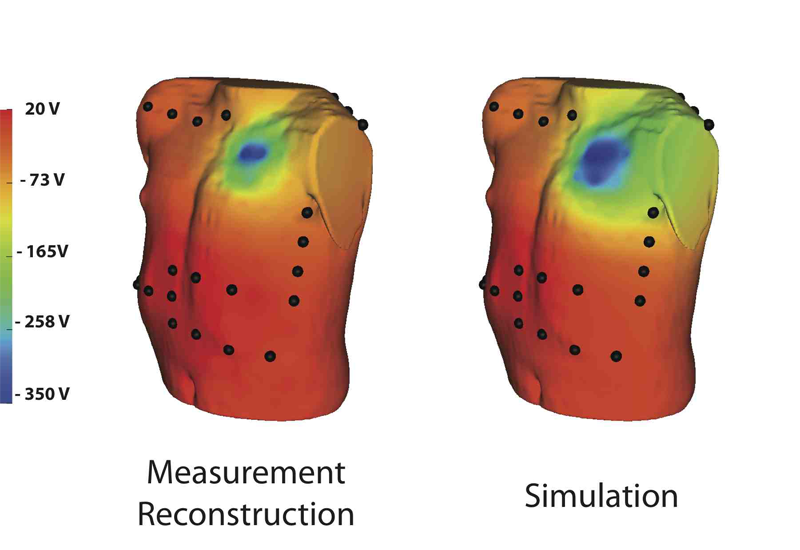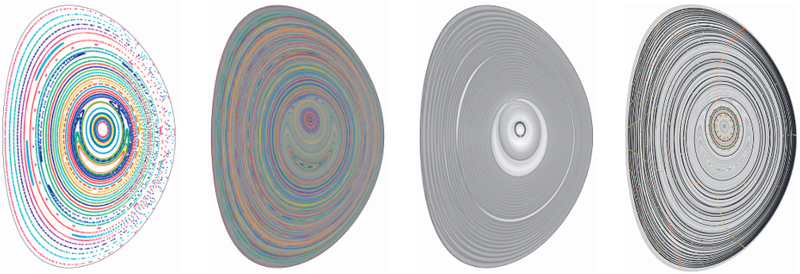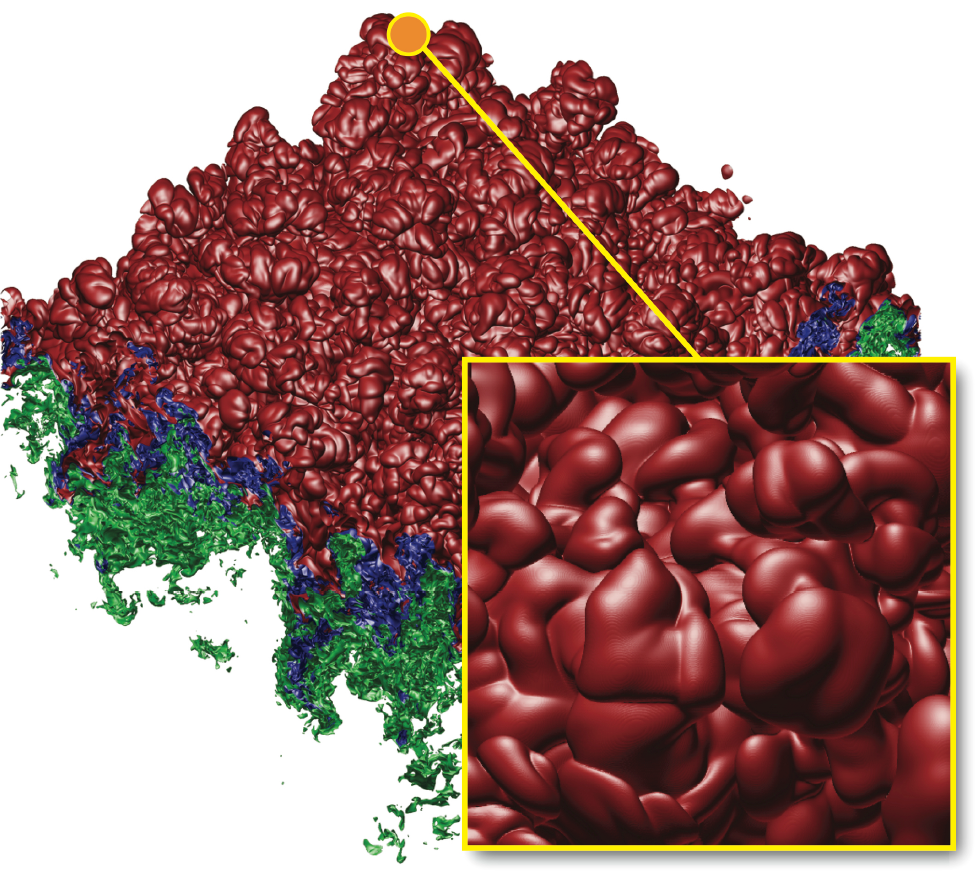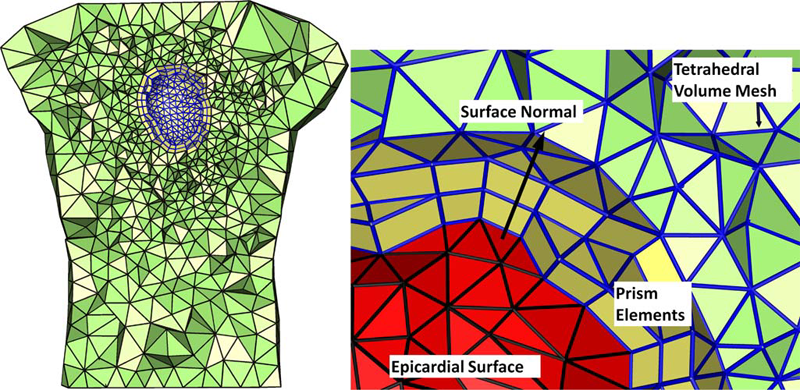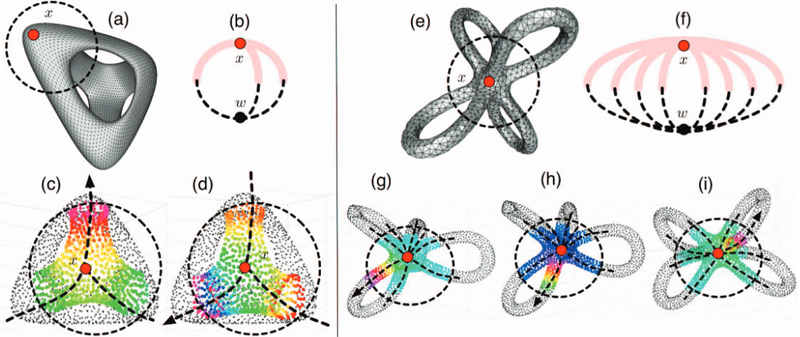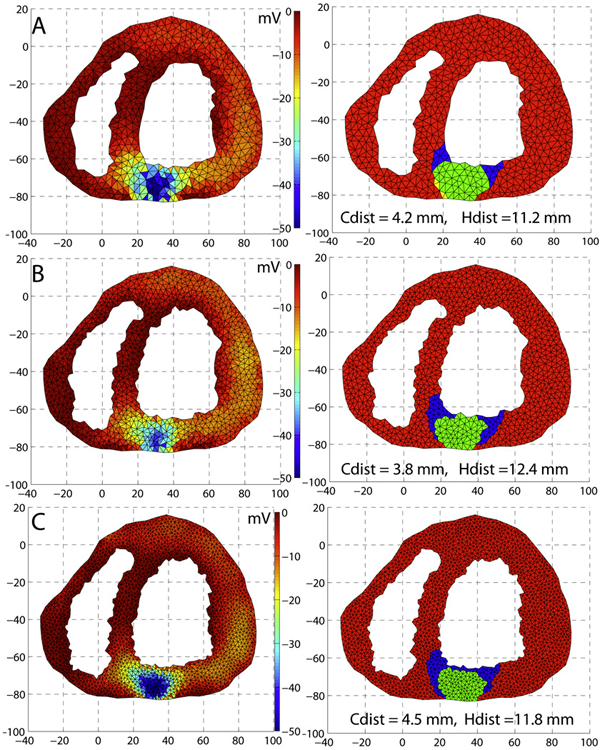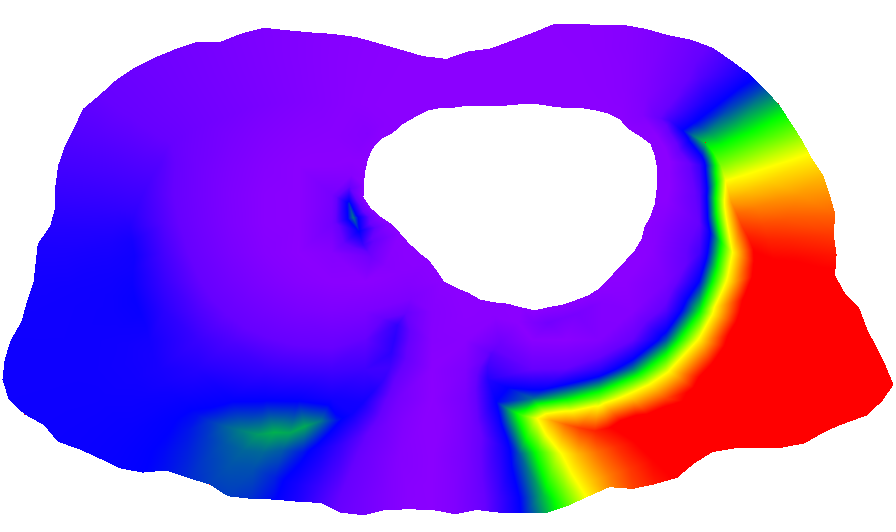SCI Publications
2011


J.D. Tate, J.G. Stinstra, T. Pilcher, A. Poursaid, E. Saarel, R.S. MacLeod.
“Measuring Defibrillator Surface Potentials for Simulation Verification,” In Proceedings of the IEEE Engineering in Medicine and Biology Society EMBS 33rd Annual International Conference, pp. 239 - 242. 2011.
ISSN: 1557-170X
DOI: 10.1109/IEMBS.2011.6090045
PubMed ID: 22254294
Though implantable cardioverter defibrillators (ICDs) are increasing in use in both adults and children, little progress has been devoted to optimizing device and electrode placement. To facilitate effective ICD placement, especially in pediatric cases, we have developed a predictive model that evaluates the efficacy of a delivered shock. We have also developed an experimental validation approach based on measurements from clinical cases. The approach involves obtaining body surface potential maps of ICD discharges during implantation surgery using a limited lead selection and body surface estimation algorithm. Comparison of the simulated and measured potentials yielded very similar patterns and a typical correlation greater than 0.93, suggesting that the predictive simulation generates realistic potential values. This validation approach provides confidence in application of the simulation pipeline and offers areas to focus future improvements.
Keywords: Electric potential, Electric shock, Electrodes;Estimation, Lead;Surface reconstruction, Torso, Algorithms, Body Surface Potential Mapping, Computer Simulation, Defibrillators, Implantable, Humans, Models, Cardiovascular, Therapy, Computer-Assisted


J.D. Tate, J.G. Stinstra, T.A. Pilcher, R.S. MacLeod.
“Measurement of Defibrillator Surface Potentials for Simulation Verification,” In Computing in Cardiology, In 2011 Annual International Conference of the IEEE Engineering in Medicine and Biology Society, IEEE, pp. 853--856. Aug, 2011.
DOI: 10.1109/iembs.2011.6090045


D. Thompson, J.A. Levine, J.C. Bennett, P.-T. Bremer, A. Gyulassy, V. Pascucci, P.P. Pebay.
“Analysis of Large-Scale Scalar Data Using Hixels,” In Proceedings of the 2011 IEEE Symposium on Large-Scale Data Analysis and Visualization (LDAV), Providence, RI, pp. 23--30. 2011.
DOI: 10.1109/LDAV.2011.6092313


L.T. Tran, M. Berzins.
“IMPICE Method for Compressible Flow Problems in Uintah,” In International Journal For Numerical Methods In Fluids, Note: Published online 20 July, 2011.


L.T. Tran, M. Berzins.
“Defect Sampling in Global Error Estimation for ODEs and Method-Of-Lines PDEs Using Adjoint Methods,” SCI Technical Report, No. UUSCI-2011-006, SCI Institute, University of Utah, 2011.


X. Tricoche, C. Garth, A. Sanderson.
“Visualization of topological structures in area-preserving maps,” In IEEE Transactions on Visualization and Computer Graphics (TVCG), Vol. 17, No. 12, pp. 1765--1774. Dec, 2011.
DOI: 10.1109/TVCG.2011.254
PubMed ID: 22034293
Area-preserving maps are found across a wide range of scientific and engineering problems. Their study is made challenging by the significant computational effort typically required for their inspection but more fundamentally by the fractal complexity of salient structures. The visual inspection of these maps reveals a remarkable topological picture consisting of fixed (or periodic) points embedded in so-called island chains, invariant manifolds, and regions of ergodic behavior. This paper is concerned with the effective visualization and precise topological analysis of area-preserving maps with two degrees of freedom from numerical or analytical data. Specifically, a method is presented for the automatic extraction and characterization of fixed points and the computation of their invariant manifolds, also known as separatrices, to yield a complete picture of the structures present within the scale and complexity bounds selected by the user. This general approach offers a significant improvement over the visual representations that are so far available for area-preserving maps. The technique is demonstrated on a numerical simulation of magnetic confinement in a fusion reactor.


P. Tsuji, D. Xiu, L. Ying.
“A Fast Method for High-frequency Acoustic Scattering from Random Scatterers,” In International Journal for Uncertainty Quantification, Vol. 1, No. 2, pp. 99--117. 2011.
DOI: 10.1615/IntJUncertaintyQuantification.v1.i2.10
This paper is concerned with the uncertainty quantification of high-frequency acoustic scattering from objects with random shape in two-dimensional space. Several new methods are introduced to efficiently estimate the mean and variance of the random radar cross section in all directions. In the physical domain, the scattering problem is solved using the boundary integral formulation and Nystrom discretization; recently developed fast algorithms are adapted to accelerate the computation of the integral operator and the evaluation of the radar cross section. In the random domain, it is discovered that due to the highly oscillatory nature of the solution, the stochastic collocation method based on sparse grids does not perform well. For this particular problem, satisfactory results are obtained by using quasi-Monte Carlo methods. Numerical results are given for several test cases to illustrate the properties of the proposed approach.
Keywords: acoustic scattering, random domains, uncertainty quantification, boundary integral equations, fast algorithms, quasi-Monte Carlo methods


N.J. Tustison, S.P. Awate, G. Song, T.S. Cook, J.C. Gee.
“Point Set Registration Using Havrda–Charvat–Tsallis Entropy Measures,” In IEEE Transactions on Medical Imaging, Vol. 30, No. 2, pp. 451--460. 2011.


G.R. Vergara, S. Vijayakumar, E.G. Kholmovski, J.J. Blauer, M.A. Guttman, C. Gloschat, G. Payne, K. Vij, N.W. Akoum, M. Daccarett, C.J. McGann, R.S. Macleod, N.F. Marrouche.
“Real-time magnetic resonance imaging-guided radiofrequency atrial ablation and visualization of lesion formation at 3 Tesla,” In Heart Rhythm, Vol. 8, No. 2, pp. 295--303. 2011.
PubMed ID: 21034854


H.T. Vo, J. Bronson, B. Summa, J.L.D. Comba, J. Freire, B. Howe, V. Pascucci, C.T. Silva.
“Parallel Visualization on Large Clusters using MapReduce,” SCI Technical Report, No. UUSCI-2011-002, SCI Institute, University of Utah, 2011.


H.T. Vo, J. Bronson, B. Summa, J.L.D. Comba, J. Freire, B. Howe, V. Pascucci, C.T. Silva.
“Parallel Visualization on Large Clusters using MapReduce,” In Proceedings of the 2011 IEEE Symposium on Large-Scale Data Analysis and Visualization (LDAV), pp. 81--88. 2011.
Large-scale visualization systems are typically designed to efficiently \"push\" datasets through the graphics hardware. However, exploratory visualization systems are increasingly expected to support scalable data manipulation, restructuring, and querying capabilities in addition to core visualization algorithms. We posit that new emerging abstractions for parallel data processing, in particular computing clouds, can be leveraged to support large-scale data exploration through visualization. In this paper, we take a first step in evaluating the suitability of the MapReduce framework to implement large-scale visualization techniques. MapReduce is a lightweight, scalable, general-purpose parallel data processing framework increasingly popular in the context of cloud computing. Specifically, we implement and evaluate a representative suite of visualization tasks (mesh rendering, isosurface extraction, and mesh simplification) as MapReduce programs, and report quantitative performance results applying these algorithms to realistic datasets. For example, we perform isosurface extraction of up to l6 isovalues for volumes composed of 27 billion voxels, simplification of meshes with 30GBs of data and subsequent rendering with image resolutions up to 800002 pixels. Our results indicate that the parallel scalability, ease of use, ease of access to computing resources, and fault-tolerance of MapReduce offer a promising foundation for a combined data manipulation and data visualization system deployed in a public cloud or a local commodity cluster.
Keywords: MapReduce, Hadoop, cloud computing, large meshes, volume rendering, gigapixels


H.T. Vo, C.T. Silva, L.F. Scheidegger, V. Pascucci.
“Simple and Efficient Mesh Layout with Space-Filling Curves,” In Journal of Graphics, GPU, and Game Tools, pp. 25--39. 2011.
ISSN: 2151-237X


Y. Wang, A. Gupta, Z. Liu, H. Zhang, M.L. Escolar, J.H. Gilmore, S. Gouttard, P. Fillard, E. Maltbie, G. Gerig, M. Styner.
“DTI registration in atlas based fiber analysis of infantile Krabbe disease,” In Neuroimage, pp. (in print). 2011.
PubMed ID: 21256236


D. Wang, R.M. Kirby, C.R. Johnson.
“Finite Element Based Discretization and Regularization Strategies for 3D Inverse Electrocardiography,” In IEEE Transactions for Biomedical Engineering, Vol. 58, No. 6, pp. 1827--1838. 2011.
PubMed ID: 21382763
PubMed Central ID: PMC3109267
We consider the inverse electrocardiographic problem of computing epicardial potentials from a body-surface potential map. We study how to improve numerical approximation of the inverse problem when the finite-element method is used. Being ill-posed, the inverse problem requires different discretization strategies from its corresponding forward problem. We propose refinement guidelines that specifically address the ill-posedness of the problem. The resulting guidelines necessitate the use of hybrid finite elements composed of tetrahedra and prism elements. Also, in order to maintain consistent numerical quality when the inverse problem is discretized into different scales, we propose a new family of regularizers using the variational principle underlying finite-element methods. These variational-formed regularizers serve as an alternative to the traditional Tikhonov regularizers, but preserves the L2 norm and thereby achieves consistent regularization in multiscale simulations. The variational formulation also enables a simple construction of the discrete gradient operator over irregular meshes, which is difficult to define in traditional discretization schemes. We validated our hybrid element technique and the variational regularizers by simulations on a realistic 3-D torso/heart model with empirical heart data. Results show that discretization based on our proposed strategies mitigates the ill-conditioning and improves the inverse solution, and that the variational formulation may benefit a broader range of potential-based bioelectric problems.


Bei Wang, B. Summa, V. Pascucci, M. Vejdemo-Johansson.
“Branching and Circular Features in High Dimensional Data,” SCI Technical Report, No. UUSCI-2011-005, SCI Institute, University of Utah, 2011.


Bei Wang, B. Summa, V. Pascucci, M. Vejdemo-Johansson.
“Branching and Circular Features in High Dimensional Data,” In IEEE Transactions of Visualization and Computer Graphics (TVCG), Vol. 17, No. 12, pp. 1902--1911. 2011.
DOI: 10.1109/TVCG.2011.177
PubMed ID: 22034307
Large observations and simulations in scientific research give rise to high-dimensional data sets that present many challenges and opportunities in data analysis and visualization. Researchers in application domains such as engineering, computational biology, climate study, imaging and motion capture are faced with the problem of how to discover compact representations of high dimensional data while preserving their intrinsic structure. In many applications, the original data is projected onto low-dimensional space via dimensionality reduction techniques prior to modeling. One problem with this approach is that the projection step in the process can fail to preserve structure in the data that is only apparent in high dimensions. Conversely, such techniques may create structural illusions in the projection, implying structure not present in the original high-dimensional data. Our solution is to utilize topological techniques to recover important structures in high-dimensional data that contains non-trivial topology. Specifically, we are interested in high-dimensional branching structures. We construct local circle-valued coordinate functions to represent such features. Subsequently, we perform dimensionality reduction on the data while ensuring such structures are visually preserved. Additionally, we study the effects of global circular structures on visualizations. Our results reveal never-before-seen structures on real-world data sets from a variety of applications.
Keywords: Dimensionality reduction, circular coordinates, visualization, topological analysis


D. Wang, R.M. Kirby, R.S. Macleod, C.R. Johnson.
“An optimization framework for inversely estimating myocardial transmembrane potentials and localizing ischemia,” In Proceedings of the International Conference of the IEEE Engineering in Medicine and Biology Society (EMBS), pp. 1680--1683. 2011.
DOI: 10.1109/IEMBS.2011.6090483
PubMed ID: 22254648
PubMed Central ID: PMC3336368
By combining a static bidomain heart model with a torso conduction model, we studied the inverse electrocardiographic problem of computing the transmembrane potentials (TMPs) throughout the myocardium from a body-surface potential map, and then used the recovered potentials to localize myocardial ischemia. Our main contribution is solving the inverse problem within a constrained optimization framework, which is a generalization of previous methods for calculating transmembrane potentials. The framework offers ample flexibility for users to apply various physiologically-based constraints, and is well supported by mature algorithms and solvers developed by the optimization community. By avoiding the traditional inverse ECG approach of building the lead-field matrix, the framework greatly reduces computation cost and, by setting the associated forward problem as a constraint, the framework enables one to flexibly set individualized resolutions for each physical variable, a desirable feature for balancing model accuracy, ill-conditioning and computation tractability. Although the task of computing myocardial TMPs at an arbitrary time instance remains an open problem, we showed that it is possible to obtain TMPs with moderate accuracy during the ST segment by assuming all cardiac cells are at the plateau phase. Moreover, the calculated TMPs yielded a good estimate of ischemic regions, which was of more clinical interest than the voltage values themselves. We conducted finite element simulations of a phantom experiment over a 2D torso model with synthetic ischemic data. Preliminary results indicated that our approach is feasible and suitably accurate for the common case of transmural myocardial ischemia.


S. Williams, M. Petersen, P.-T. Bremer, M. Hecht, V. Pascucci, J. Ahrens, M. Hlawitschka, B. Hamann.
“Adaptive Extraction and Quantification of Geophysical Vortices,” In IEEE Transactions on Visualization and Computer Graphics, Proceedings of the 2011 IEEE Visualization Conference, Vol. 17, No. 12, pp. 2088--2095. 2011.


C. Yang, D. Xiu, R.M. Kirby.
“Visualization of Covariance and Cross-covariance Field,” In International Journal for Uncertainty Quantification, Vol. 3, No. 1, pp. 25--38. 2011.
DOI: 10.1615/Int.J.UncertaintyQuantification.2011003369
We present a numerical technique to visualize covariance and cross-covariance fields of a stochastic simulation. The method is local in the sense that it demonstrates the covariance structure of the solution at a point with its neighboring locations. When coupled with an efficient stochastic simulation solver, our framework allows one to effectively concurrently visualize both the mean and (cross-)covariance information for two-dimensional (spatial) simulation results. Most importantly, the visualization provides the scientist a means to identify interesting correlation structure of the solution field. The mathematical setup is discussed, along with several examples to demonstrate the efficacy of this approach.
Keywords: netl


H. Zhu, L. Kong, R. Li, M.S. Styner, G. Gerig, W. Lin, J.H. Gilmore.
“FADTTS: Functional Analysis of Diffusion Tensor Tract Statistics,” In NeuroImage, Vol. 56, No. 3, pp. 1412--1425. 2011.
DOI: 10.1016/j.neuroimage.2011.01.075
PubMed ID: 21335092





